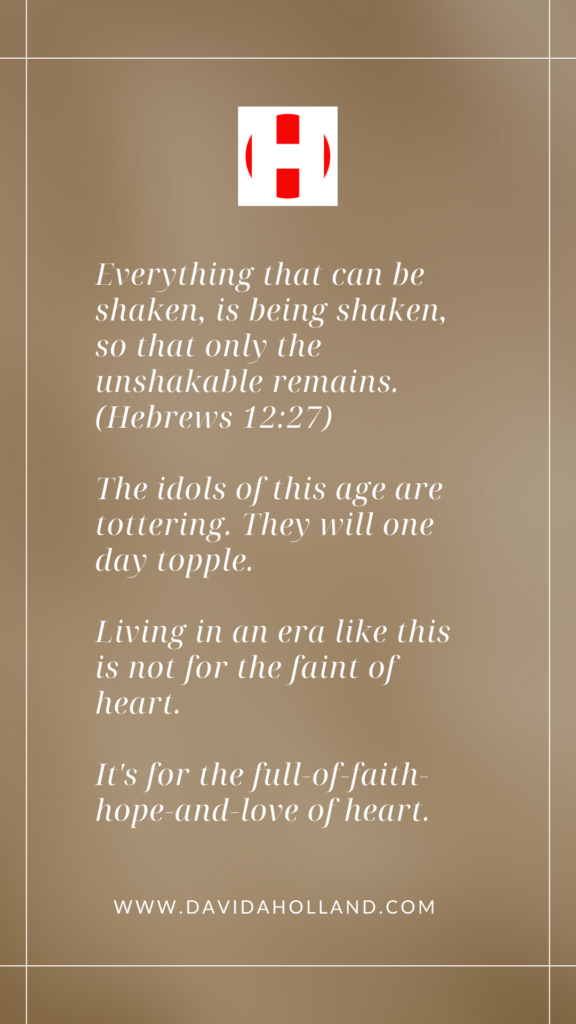
They’re Wobbling


Just posted some fresh, half-baked thoughts over at the Cup & Table Co. blog:
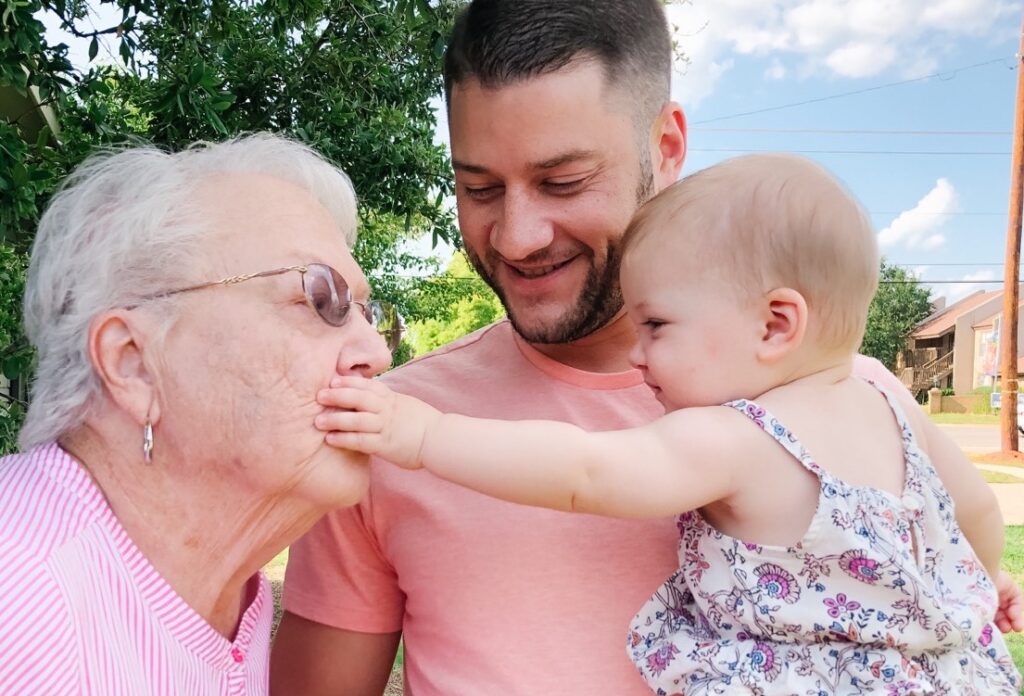
You can see terrible things on the Internet. And once you see something, you can’t unsee it.
Last week I stumbled across a video that I wish I hadn’t. Having watched it, I can’t stop thinking about it. And having thought about, it’s made me mindful of something very important and relevant about this particular moment in history.
That “moment” is one in which powerful forces are endeavoring to pull down and replace as many aspects of Western civilizational heritage as possible, and do so in the name of justice and equality. There’s a great and terrible irony in that, which I’ll get to in a moment.
The video I saw was security camera footage of a side street in the major Chinese city of Foshan. (My sincere apologies in advance for what I’m about to share with you. As horrific as this description will sound, it’s actually worse than what I’ll describe. And I will not be linking to it. You’ll just have to take my word for it.)
Although I’d never seen it or heard about, I’ve since learned that the video was leaked and went viral back in late 2011. (<-Wikipedia article)
The now infamous surveillance camera footage of a busy street shows a two year old little girl, Wang Yue, toddling out into the street and standing there for a moment before being hit by a very slow moving delivery van.
The child is knocked down and then the front, passenger side tire runs over her body. The puzzled driver pauses for a few seconds. The proceeds so that the rear tire also runs over her. I wish I could tell you that this is the worst of it.
The child lies in the street, moving perceptibly, as dozens of people walk by without stopping. One man literally steps over the toddler. There are people everywhere, but no one helps. No one intervenes.
Eventually, a another truck comes into view.
When watching the the video for the first time, you think, “Oh good, this driver will stop and get out of the truck to check on the child lying in the street.”
Oh, how I wish that was what happens.
The truck slows momentarily to assess the obstacle, and then keeps moving forward. The driver doesn’t even make an attempt to steer around little Yue.
She doesn’t move any more after that. But people continue to walk by her and around her, as if she’s not there.
As it turns out the video became a national embarrassment in China, and a horror and a byword around the world. But it illustrated a truth that many of us have known for a long time. Human life is cheap in China.
The fact is, human life is cheap in lots of places around the world. I’ve visited many of them. I’ve been to places where the locals think nothing of seeing a human body lying in a ditch or floating down the river.
Most of us who were born into Western cultures were raised with an ethic that assumed every human life was signficant. Even the lives of people we don’t know. We share a core cultural sensibility that human life is distinctly precious.
Even after 47 years of legalized abortion in the U.S., we’re still not comfortable with it as a culture. Christians (for the most part) oppose it. Feminists and Progressives reveal their discomfort with it by creating euphemisms like “lump of tissue” to avoid having to think about what they’re really talking about. There’s a deeply ingrained civilizational reason for that.
It’s the same reason the videoed death of George Floyd blew open a hole of horror and disgust so wide in the American public’s psyche, that Progressives, Marxists, and anarchists sensed (correctly apparently) that they could drive anything on their wish list through it.
And a long and ambitious wish list it is. Sensing the opportunity in the widespread revulsion at the taking of the life of a helpless black man, the enemies of Western culture blew right past police reform, and even past meaningful racial reconciliation, in order to advance a more radical agenda of symbolically and actually pulling down the Christianity-rooted civilization that has made the United States a land of opportunity and promise for numerous generations seeking a better life.
Yes, our esteem for human life is a product of that culture. But we take it for granted. And we think that most people all over the world hold that truth to be self evident, too. They don’t.
They don’t in the sprawling red light districts of Bombay and Calcutta. They don’t in the militia camps of the Congo. They don’t in the palaces of Saudi royalty. And they don’t in the work camps of China.
We also tend to think that this is the way people have always thought, but a review of history will reveal that this is not the case.
In all places and all times, human life has usually carried the same value as it did for those people stepping over the crushed body of a dying toddler.
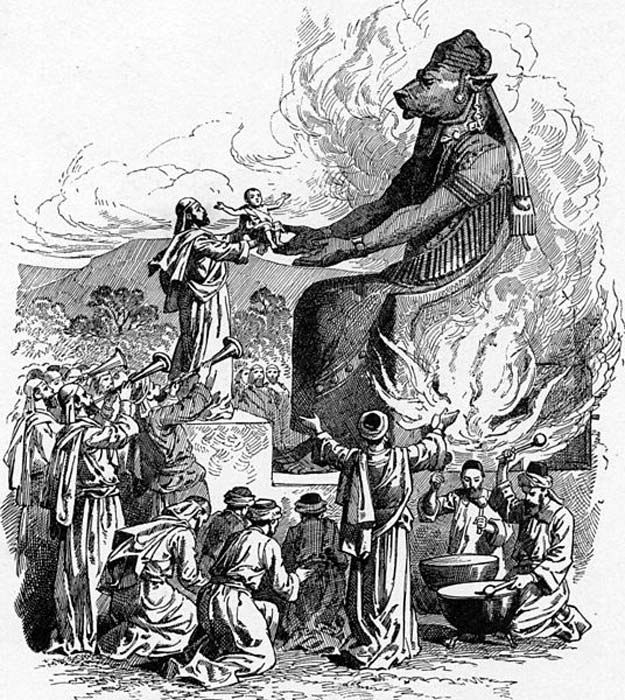
It was true of the ancient Greeks. The Spartans famously required the city leaders to examine every newborn child to determine if it was fit to live.
Likewise, Aristotle argued that parents should be compelled by law to expose deformed or handicapped babies. To “expose” an infant was to abandon it on the city’s garbage heap so wild animals or the elements would kill him or, more commonly, her.
I recall reading a translation of a letter written by a Roman soldier in 1 B.C. The soldier was deployed far away from his pregnant wife. After encouraging her to take care of herself and the unborn child growing within her, he writes, “If you have the baby before I return, if it is a boy, let it live; if it is a girl, expose it.”
Early Christians in many Roman cities used to check the preferred exposure sites daily in order to rescue and raise abandoned babies . . . who were usually girls.
Girl babies back then, as now in many places around the world, are killed without a thought. But not in the U.S.. Not yet, anyway, although we now have our advocates for sex selection abortions and terminations for imperfect babies. But these advocates have clearly rejected the traditions of Western (Christian) Civilization.
Even so, we are still a culture that values life. It’s why, in the midst of the Covid-19 pandemic, our default response as a society is to risk impoverishing millions in order to preserve the lives of thousands. Even if a good number of those thousands were likely to die in the next year or so anyway.
That’s how much we value life as a culture. So, where does this ethic come from?
Certainly not from Eastern cultures. Not from Marxist ideology. Not from paganism. No, it is a legacy of a Christian heritage that, in ways unique among all the civilizations that currently exist, or have ever existed, holds human life to be precious.
As historian Tom Holland has noted in his extraordinary new book, Dominion: How the Christian Revolution Remade the World . . .
To live in a Western country is to live in a society still saturated by Christian concepts and assumptions.
Even while our Western system of values is being rejected and vilified by several generations of Americans, that legacy persists. It’s in our cultural DNA. For the moment, anyway.
That brings me to the irony that I mentioned above.
Those pulling down the statues of “dead white men” and calling for an end to our economic and political “systems of oppression” are attacking the very thing that best produces the things they say they value most.
For example, whereever the seeds of the gospel have taken root and flourished, cultures have emerged in which the value of human life rose. How could a faith built on “God so loved the world . . .” produce anything else.
When the New Covenant transforms a critical mass of people for multiple generations in a place, the status of women invariably rises. They go from being treated like property or children—as is the case in many cultures throughout history and across the world today–to enjoying largely the same rights as men. How could a Kingdom that affrims that “in Christ there is neither male nor female” have any other effect?
Slavery? The abolitionist cause rose and grew in Great Britain largely through the empire’s pulpits and prayer meetings. Then the same in the fledgling, expanding United States. Ultimately, the British Empire became the world’s most powerful force for ending the slave trade. And the United States fought one of history’s bloodiest civil wars over ending its expansion.
How could worship of a King who described His mission as proclaiming release to the captives and setting free the oppressed result in any other ethic?
Even the “animal rights” movement could (but won’t) see its ethical forerunner in the churches of Great Britain. The same men and women who formed the spiritual and intellectual hub of the abolitionist movement in Great Britain—William Wilberforce, Hannah More, et.al.,—voiced the first calls for “animal welfare” reform. And Christians wrote the world’s first animal cruelty laws in Ireland, England, and the American colonies.
Well, that’s not quite true. The first codified prohibition against animal cruelty is in the Bible. (See: Ex. 23:5; Lev. 22:8; Deut. 22:6; Deut. 25:4; Prov. 12:10)
Of course, the Christian ethic of championing animal welfare has mutated in our time into a belief in animal rights. That’s a very different thing.
That shift began in earnest back in the ’60s and ’70s. Back then, in their youth, the Boomer generation that runs most of the country’s institutions today, convinced themselves (with a lot of spiritual help) that the Western foundation that had delivered so much progress wasn’t bringing change fast enough. That, in fact, it was the problem, rather than the solution.
So they embraced modernized versions of Eastern religions. Those religions hold that “all” life is equally precious. That the life in insects and reptiles and chickens is no less sacred than the life of a child.
Jesus once rebuked the Pharisees saying, “You blind guides! You strain out a gnat but swallow a camel.” (Matt. 23:24)
It appears that in Jesus’ time, some of the ancient Pharisees had adopted a practice very similar to followers of the Jain religion in India–they drank water through a piece of cloth so as to not accidentally ingest a tiny insect such as a gnat.
The Pharisees did this because insects were unclean, forbidden food according to Levitical law. The Jain do this to this day because they are not permitted to take animal life in any form. For this same reason, they are not allowed to eat after dark because this might involve accidently swallowing a gnat.
The fruit of this ethic and similar ones is evident throughout the cultures rooted in Eastern religions. Elevating the value of animal life has the effect of diminshing the value and uniqueness of human life.
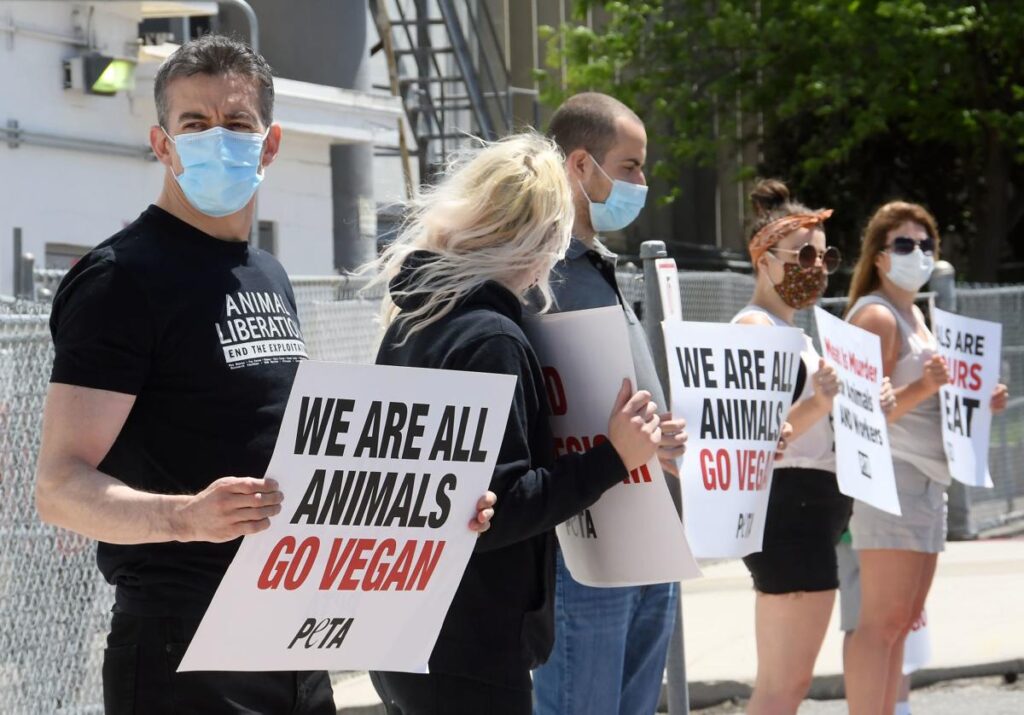
Thus we have exchanged the Christian, compassionate animal welfare ethic for a pagan religious paradigm that invariably results in death and misery for humanity. It’s no coincidence that places where this is the deeply-rooted dominant view are among the worst places on earth to be born poor, or a girl.
Which brings us to an unpleasant, under-appreciated reality.
The only alternative to the Western heritage currently under assault is— paganism. Not modernism. Paganism. Modernism is an expression and effect of the Kingdom of Jesus Christ.
In a very real sense, the battle lines currently being formed are about the re-paganization of the West. (Please note the number of wiccan, druid, neo-pagan, and gaia worshippers in the ranks of the Progressive vanguard.)
And that means that just a lttle farther down this path, a lot of very sweet, very well-meaning pastors and Christians who, with the best of intentions, have embraced this “social justice” moment are about to find themselves in an awkward position.
They will discover they’ve unwittingly become a part of the furious hacking at the limb we’re all sitting on and, in the process, having weakened the very institutions that hold out the best hope for advancing justice and equality . . . and life . . . for everyone.

This time, like all times, is a very good one, if we but know what to do with it.
Ralph Waldo Emerson
Everything is terrible. It’s all just the worst . . . the absolute worst.
This is what most people in the Western world walk around thinking most of the time. It’s not true, of course. Things are generally pretty great. The fact is, wherever it has spread, Western/Christian Civilization has created levels of comfort and abundance that are nothing short of mind boggling.
The typical American, even one of modest means, lives a life that medieval kings would envy. For most of human history, people spent most of their days trying to acquire enough food to keep their family alive. Winter was a dreaded existential threat.
Today Food is so abundant and affordable that it’s no longer about survival or even sustenance. As hundreds of television series testify, food is now about art and pleasure and style, and frequently, virtue signaling. It’s a luxury no generation on earth has even been afforded.

Instead of spending our days scrounging and scraping for food and fighting off invaders, we indulge in pursuits available only to the ultra-rich just a couple of generations ago. We’re free and able to dabble in art, style, design, hobbies, and travel–both in reality and in our television viewing and internet browsing.
The struggle for shelter has become a quest to express your individual design style and aesthetic in the most authentic way possible. And our major unconquered diseases are the ones associated with old age.
To be sure, infant and child mortality are still heartbreaking realities is some corners of the world, but almost exclusively in those places where the gospel and Christian Civilization has not yet worked its tranformative wonders.
No matter what measure you use:
. . . the statistics show that things have never been better.
By the way, if you want to understand how and why Christianity made all this progress possible, I highly recommend this brand-new book by the UK historian Tom Holland (no relation!). It’s beautifully written and absolutely fascinating:
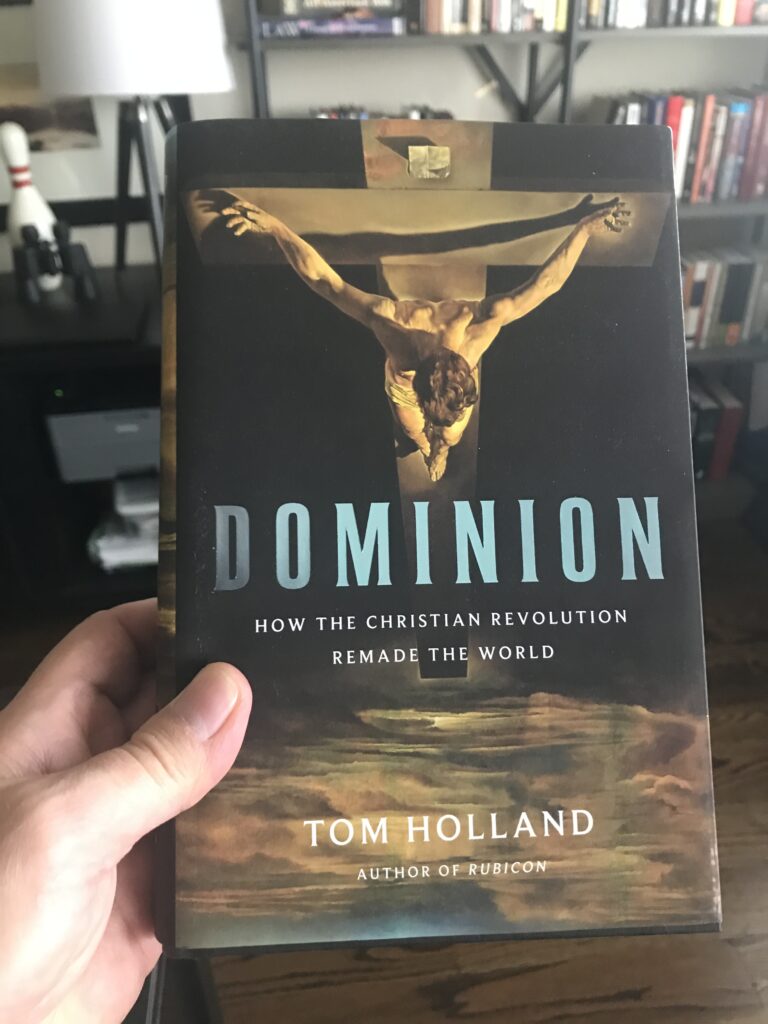
So given all of this good news, why are we all walking around with clenched teeth and knots in our stomachs? As if there have never been grimmer, darker times than this particular moment? I addressed this question, in part, in a recent white paper I presented at a theological round table. Here’s an excerpt:
Three factors work together to cause us to over-estimate the present power and success of what Paul called “world forces of darkness.”
One is the 24-hour instant news cycle—enabled by the Internet and fed by ubiquitous video cameras in more than 3.5 billion smart phones worldwide. If something horrific happens anywhere in world, we’re all watching video of it and shaking our heads in sadness within the hour (and sharing it with all our friends on social media).
The second is our woeful ignorance of history. We have little understanding of how dark things in the world really were prior to the dawning of the light of the Gospel. Nor do we have the information that allows us to put in perspective the transformation the world, and the kingdoms of this world, have undergone as the carriers of that light have spread across the planet.
(By the way, if you want a little historical perspective on what truly crazy times previous generations lived through, check out a series of posts I wrote called, “We’ve Seen This Before.” Here, here, and here.)
The third is an America-centric myopia. Believers here in the U.S. often come perilously close to conflating the Kingdom of Jesus and our own nation-state—as if they were one and the same thing. We also observe what has happened in what has come to be called “post-Christian” Europe, see many of the same patterns being replicated here, and leap to the conclusion that the lights are going out all over the world.
The fact is, the Gospel is advancing in extraordinary ways all over the planet.
There is another reason we all seem to believe that things are terrible when they’ve never been better.
With our phones constantly in our hands and computers on most workplace desks, we’re spending massive amounts of time online. And the online marketing world has learned to monitize outrage, fear, resentment, and horror.
Clicks equal money. And nothing generates clicks like news designed to enrage, alarm, or frighten you. Attention is the scarcest commodity in our economy, and few things attract attention like tragic news or someone saying something infuriating.
As a result, massive digital fortunes are being made by inundating you with online ads filled with headlines crafted and meticulously tested to trigger fear or anger in you.
Likewise, “likes” and “shares” are the currency of the social media world. Thus our social media feeds overflow with links to stories designed to have the same effect. We share and retweet the outrage of the moment in hopes of feeling significant or striking at perceived enemies. (This’ll show ’em!)
Esseentially, we’ve all voluntarily signed up to be bombarded throughout our waking ours with news, posts, and ads intentionally crafted to stir up negative emotions. Is it any wonder an entire generation of people are convinced that everything is terrible?
Many aspects of this are not new. The news business has always known that bad news sells papers much more effectively than good news.
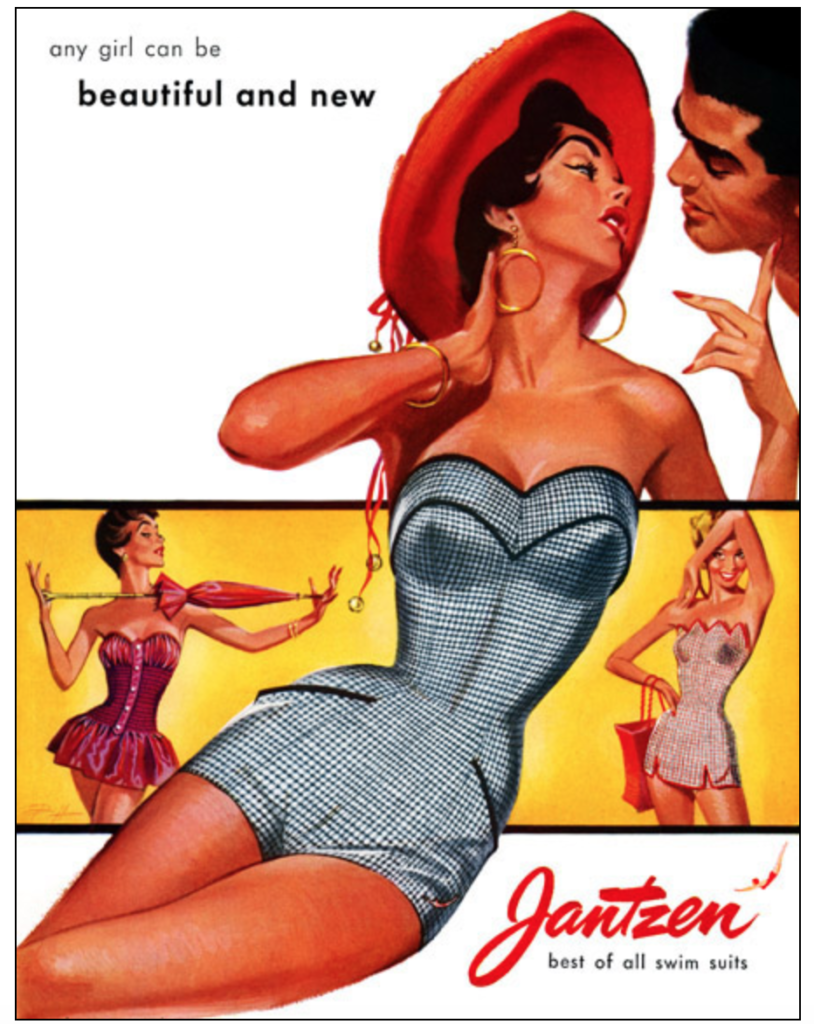
And from the very beginning, the advertising industry has understood that the most effective ads play upon our deepest fears and insecurities.
Ads are designed to make us feel like we’re not enough, or don’t have enough, or that others who have more are more significant or more happy. And the science of psychology has made advertisers more effective at these things than ever before.
One of Satan’s primary tactics is to accuse. He is, at the vile, miserable core of his being, an Accuser. It seems it’s not just people he accuses. He’s smearing our times. And in the process robbing us of much peace, contentment, and hope.
It can’t be healthy to walk around angry and fearful all the time. Silence the accuser.

I was nine and had a special parental dispensation to stay up as late as I could manage to keep my eyes open.
Like countless other little boys in the late sixties, I was captivated by space travel and astronauts. And on this night, men were walking on the surface of the moon.
The Eagle had landed at 3:17 that afternoon, Wilburton, Oklahoma Daylight Time. Around 7:15 Neil Armstrong took a small step and created a human footprint on another world. Walking outside a little later, I found the half-moon low in the pink western sky, chasing the recently set sun. I recall thinking, “Men are up there. Brave men. Men from my country.” I also remember wondering what amazing places we would be exploring when I was my father’s age.
Today I am ten years older than my father was on that wondrous night. Of course, we haven’t had many “gee whiz” moments since that era. But I must admit that some of the pictures those little rovers on Mars sent back were pretty stunning. And more than a few of the images of Saturn and her moons delivered home by the Cassini-Huygens were simply jaw-dropping:

Take a look at the above image in full glorious resolution (here) and you will see a pale blue dot inside the next-to-outermost ring on Saturn’s left side. That dot is home. It is Earth, as seen from almost a billion miles away.
It has become increasingly clear that it is not government-funded space exploration that is going to be providing our gee whiz moments in the future. As Bill Whittle points out in this wonderful video piece for Pajamas TV (free registration required), if we’re ever going to see a real version of Star Trek’s USS Enterprise, it most likely is going to built by private enterprise.
Last year, the National Geographic Society marked the 40th anniversary of the Apollo 11 landing by releasing freshly restored video imagery of the mission. Enjoy. And feel the wonder again.
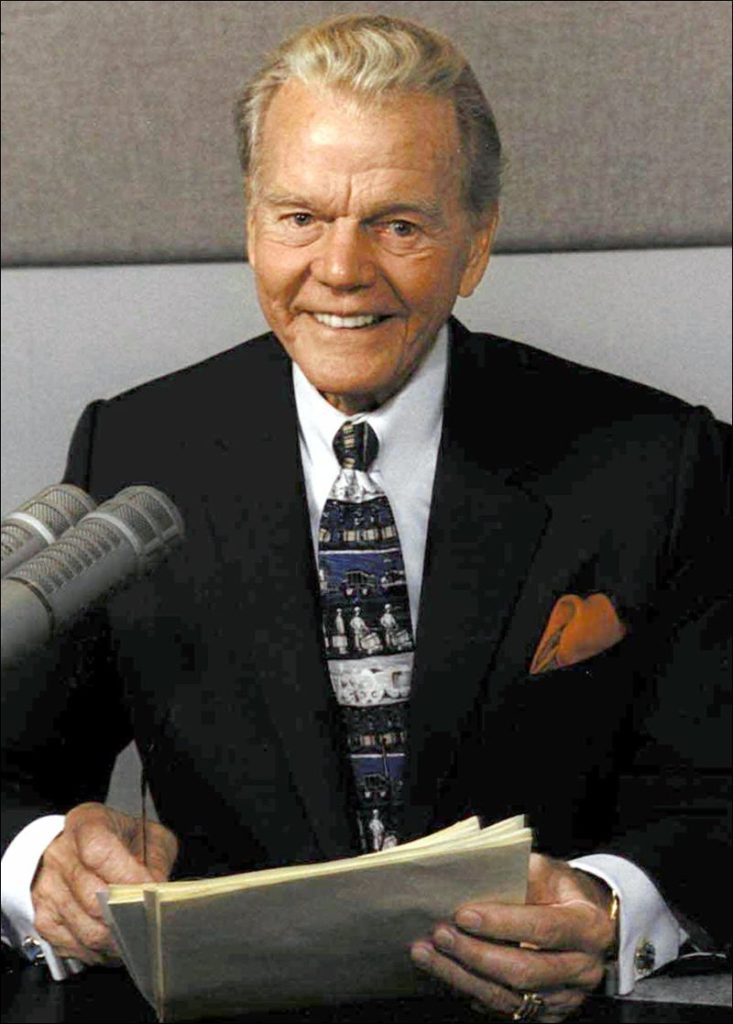
Paul Harvey passed away ten years ago today. In tribute, here are a few words we wrote at the end of the Introduction to “Paul Harvey’s America.” They still ring true for me:
“There are some who suspect that something in America died with Paul Harvey—or is dying as time relentlessly claims the remnants of what has come to be known as “the greatest generation.” Something precious and noble and good.
“And though Paul Harvey is gone and his generation is now passing away, perhaps the flame of that American spirit can be rekindled in remembering who they were and what they meant to us. Paul Harvey, ever the optimist, would have believed so.
“On the pages that follow, then, let’s gather ‘round the fire of this amazing life and warm ourselves in its good-humored glow. Perhaps we’ll take away a few sparks and embers that can light our way in the gathering gloom of the twenty-first century.”—Paul Harvey’s America
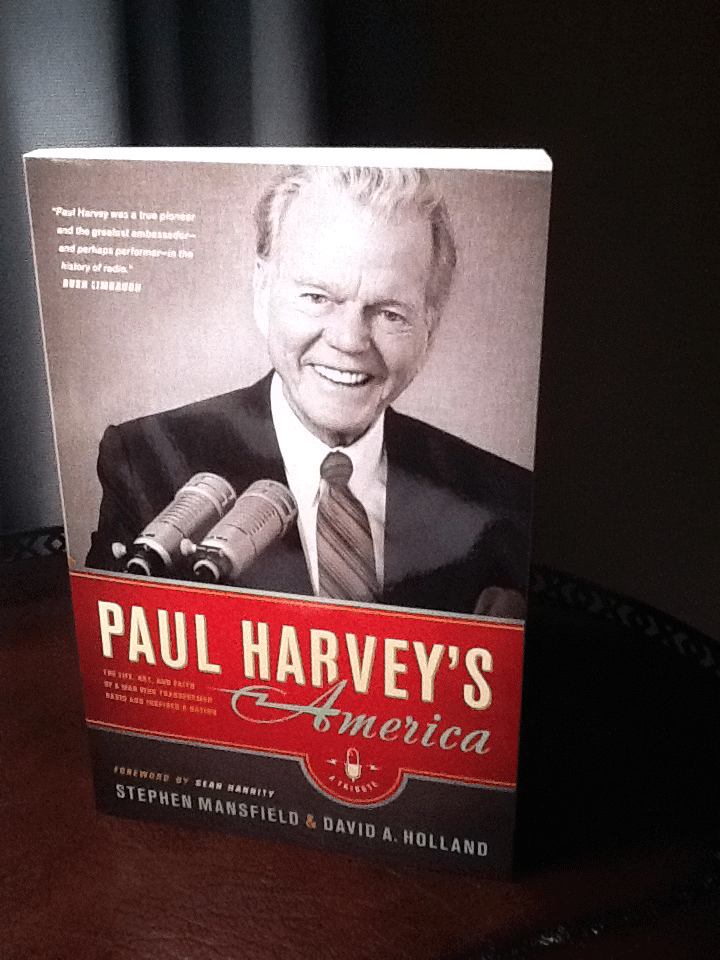
So . . . that recent ugliness and bloodshed in Charlottesville . . . some thoughts about the larger meaning and historical context. (Because that’s what I do here, provide historical, biblical context for current events.)
The Iran-Iraq War (1980-1988) taught me a jarring lesson I’ve never forgotten. Namely, that not every conflict features a side that good people can root for. Lifetimes of reading fiction, and watching movies and television, have left us all with an unthinking, unquestioned assumption that in every war there is one side that is “right” and another that is wrong.
But when Saddam Hussein’s Iraq invaded Ayatollah Khomeini’s Iran there was nothing for decent people to do but sit back wish that somehow both sides could lose.
The Iraqi’s were using chemical weapons and indiscriminately targeting civilians.
At the same time the Iranians were recruiting tens of thousands of young inexperienced volunteers and recklessly throwing them into battle in pointless human wave assaults.
Whenever they encountered an Iraqi minefield, they convinced or coerced child soldiers to walk through the fields to clear them—by setting off the mines with their bodies.
Again, in Iran vs. Iraq, there was no one to “root for.” Both sides were despicable in their own distinct way. A victory for either side would mean their particular brand of evil would advance, and many would suffer.
In some conflicts, everyone is the bad guy.
I was reminded of this truth while following the events in Charlottesville, Virginia over the last few days. The reprehensible “white nationalists” who showed up Friday night with tiki torches from their local home improvement stores were instantly mocked by liberals and conservatives alike. Here’s Sonny Bunch of the conservative Washington Free Beacon:
Of course, mockery and humor is a human coping reflex. The reality is that these angry, foolish, mis-educated, boneheads are drinking from a toxic, demonic ideological fountain.
As we know, the next day a small army of counter-protestors descended upon poor Charlottesville. These were to some degree the usual suspects—the professional marxist and anarchist protesters who can be counted on “occupy” Wall Street, rage against capitalism at G7 summits, or shut down a freeway for the environment. However, many of these perenniel protesters are now marching under a new flag. The call themselves “Antifa.” Here’s the opening paragraph of the Wikipedia entry on the group:
Antifa is a left to far-left, anarchist political movement of autonomous, self-described anti-fascist groups in the United States. The term is loosely used with anti-racism, anti-sexism, anti-homophobia, as well as Anarchism and anti-capitalism.
As we now know, the violent conflict that both sides seemed to be prepared for and to actually crave, unfolded, with tragic results. A young woman was killed and many others critically injured when a clearly unbalanced, amped-up white nationalist bro borrowed a page from the Islamists playbook and rammed a shiny new Dodge Challenger at high speed into a crowd.
Sadly, it is the 1930s all over again. As numerous posts on this site have revealed, “We’ve Seen This Before.” Here’s what I mean by that.
A Little History
The first half of the 20th Century is essentially a story of two murderous giants locked in a titanic fight to the death—Marxist Communism and Fascist Nationalism. This death match was well underway decades before Nazi Germany invaded Soviet Russia in the summer of 1941.
Meanwhile, democracies like Great Britain and United States—what Winston Churchill liked to call “Christian Civilization”—represented a third way. Let’s call it Christian Capitalism. The Christian Capitalist nations largely looked on from the sidelines as the two competing totalitarian evils fought each other, trying to figure out who to root for based on their own national interests.
The two movements were actually cousins. This was a battle between those who advocated “international socialism” (the marxists) and those who championed “national socialism.” (indeed the official name of the Nazi party in Germany was the National Socialist Party.) Thus the fight was about whose utopian socialist vision was going to prevail.
By the way, it’s proven axiom of human tribal behavior that small differences between similar groups results more furious hatred and resentment than the large differences between very different groups. This is why Protestant denominations have continually splintered into ever-smaller sub-denominations.
 Throughout the ’20s and ’30s, Communists and Fascists were vying for political power in numerous European countries. And that struggle erupted into a full blown civil war in Spain.
Throughout the ’20s and ’30s, Communists and Fascists were vying for political power in numerous European countries. And that struggle erupted into a full blown civil war in Spain.
In the late ‘30s, Soviet Russia-aligned Marxists fought Nazi Germany-aligned Fascists in the streets of Spanish cities. Meanwhile, back in the USA and Great Britain, the same artists, actors, novelists, and screenwriters who had romanticized and rooted for the Communist takeover of Russia, began to do the same for the cause of the Communists in Spain.
For a time, Earnest Hemingway embedded himself as a journalist with the Communist rebels in that war and his writing helped further romanticize the cause. He also wrote and funded a propaganda film designed to create sympathy for the communist side.
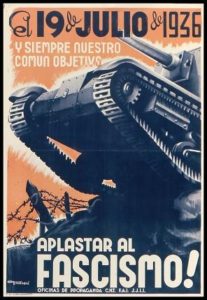 After the fall of the Soviet Union, many Kremlin records were made public. Among the revelations was that Hemingway had been recruited as a Soviet operative and was on the payroll of the KGB.
After the fall of the Soviet Union, many Kremlin records were made public. Among the revelations was that Hemingway had been recruited as a Soviet operative and was on the payroll of the KGB.
Again, let me be clear about this, both sides in these struggles for power were and are demonic and reprehensible. Millions of innocents died under Nazi rule. Many millions more died under Communist rule. As with the Iran-Iraq war, there is no side to root for when these two idolatries clash.
But the Arts and Academics crowd has always been infatuated with the Communist-Anarchist side of this evil equation. And have actively worked through movies and other forms of entertainment to encourage you and I to make the same choice. Liberals are largely romantics. Or more likely, extreme romantics are more likely to be liberal. And they find the egalitarian narrative of Communism irresistable.
The problem is that the socialist promise of equality for all is a trap. As in Venezuela currently, after surrenduring your freedoms, everyone ends up equally poor (except for a small clique of privilged elites.)
Think the upraised fist as a symbol of #Resistance is new? As the picture of the Spanish kids at the top of this page reveals, it’s older than the open palmed fascist “heil.”
Both ideologies are anti-Christian and anti-Semitic at root and core. Both have resulted in the deaths of millions and millions. Both are authoritarian and freedom-hating.
These two ghosts of the last century are walking among us again. And it is presenting us with the same challenges the Christians of Spain and Germany faced 100 years ago.
Boston
In our rush to rightly recoil from and reject one great evil (white nationalism) we can find ourselves tacitly endorsing (or at least accepting) the anti-Christian, anti-biblical premises of the other race-based ideology. That’s a mistake. It’s a mistake the Left and its media allies want to help you make.
The “white nationalists” and alt-right numbskulls can turn out a couple of hundred people at most for one of their tiki torch jamborees, while Antifa and it’s affiliated groups— many of which have billionaire benefactors like George Soros—can turn out tens of thousands on short notice.
(Have I mentioned that I find the racists, Nazis, and white nationalists reprehensible? I truly do.)
This is precisely what happened in Boston yesterday. There, a puny white nationalist rally was dwarfed by an estimated 20 thousand counter demonstrators. A small subset of these, the hard-core Antifa marxist-anarchists threw rocks and bottles filled with urine at police.
Please don’t take my word about the aims of the Antifa movement. Take them at their word:
These are the guys “all decent people” are supposed to be siding with in this mud-wrestling match.
Of course, the racists are despicable in their own special ways.
Why do I keep re-empasizing how vile and nasty I find racism in all forms, particularly white supremicism? First, because it’s true and I don’t want to be misinterpreted. But also because the current environment of hysteria demands it.
Right now there is a push to use the appearance of these nasty little frat boys and their kreepy klanny uncles as a club to beat the vast, decent middle of our society into embracing the equally demonic agenda of the anti-Christian, anti-Semitic left.
In other words, if you’re not for Antifa, you’l by default a Nazi.
Example, Dave?
A few days ago poor Ed Werder, a longtime football analyst for ESPN, and a profoundly decent human being, got called out on Twitter for preferring to stick to writing about sports rather than weigh in on the side of the social justice warriors:
This is the club we’re all about to get beaten with: “If you refuse to take the side of the Marxist-Anarchists then you’re taking the side of the Racist-Nazis.”
But this is a false dilemma.
As in the ’20s and ’30s, the times would like to insist that Christians choose between two demonic anti-Christ idols, and worship at its altar. There was a third choice then. There is a third choice now.
I’m sorry, but it requires little courage for white Christians to make social media statements condemning racism. I’ve made them. Meant them. Will continue to make them. But the social costs for engaging in this kind of “virtue signaling” are very low.
What is becoming increasingly costly is taking a principled stand against both kinds of evil. In fact, the view I’ve just expressed is now being derisively condemned as “both sides-ism” by the Left.
However, just because there’s a name for it doesn’t mean it’s wrong. Evil is evil. An Anti-Christ spirit is an Anti-Christ spirit. And when two brands of evil go to war, anyone who insists that I pick a side is going to be sorely disappointed.
I continue to stand on the side of my brothers and sisters in Christ, regardless of skin tone, sex, or nationality. If you’re “in Him,” I’m with you.
But if you’re against Him, you’re on your own.
H H H H H
Recommended Reading:
It seems that with many of the truly important things in life, we don’t really understand how to value them until they’re gone.
Dad would have been 88 this Tuesday. Father’s Day always fell around, or on, his birthday. So we’re doubly mindful of him this weekend.
I honor him today by reposting the eulogy I delivered on behalf of my siblings at his homegoing service several years ago.
John F. Holland
June 20, 1929–October 11, 2010
It is customary, at a moment like this, to mention some of the attributes and achievements of my father–in other words, to talk about who he was. Instead I want to share a few thoughts about who Dad was not.
Our father was not pushy.
At home, as in his work life, he was not prone to imposing his will or asserting his opinions. And he did not enjoy confrontation. I get that. I’m temperamentally wired in a similar way.
I vividly remember one of the few occasions in which he really tried to change my mind about something–probably because it was such an unusual occurrence.
As a father, he would offer you his opinion but wouldn’t push it. He would occasionally offer you his advice unsolicited. Most of the time he would not opine unless asked. When he did offer advice, He was usually right. And when you ignored his advice, as I often did as a younger man, and made a royal mess of things, he would invariably be right there to help you mop up in the aftermath and without the standard and customary I-told-you-so.
It was the early seventies, I was about 13, and I had been lobbying Mom heavily to buy me my first pair of big bell bottom pants. Dad got wind of it. He had already, with some difficulty, reconciled himself to the longer hair which had increasingly become the fashion since the late ’60s. But now his oldest son was asking to dress like some character from Laugh In or Love American Style. He wasn’t a fan.
I remember being startled at how strongly he tried to talk me out of those pants I wanted. It was so out of character for him. I parried with the universal comeback utilized by all kids challenging a mystifying directive from a parent: “Why?”
He initially struggled to come up with a cogent, logical case for his ban on bell bottoms. After floundering for a minute, he finally asserted–in so many words–that wearing bell bottoms could make me gay.
My recollection of his argument was not that bell bottoms would make me look gay, but rather that the pants were somehow imbued with exotic properties and powers that could actually make me gay.
I’m reasonably sure he was wrong about that. But he was right about most things–especially the things that mattered.
The long hair and the bell bottoms were just superficial manifestations of deeper cultural shifts taking place in our country in those years. And he didn’t like the way the winds were blowing. He was absolutely right to be wary.
I think that was one of the things that moved him to relocate our family from Oklahoma City to Wilburton. In the summer of 1965–the year the nation saw escalation in Vietnam, rising unrest on college campuses, and race riots in Watts–he moved the four of us as far out in the country as he possible could while still improving his job prospects as an aspiring college professor.
He saw the hills of rural southeastern Oklahoma as a good place for a kid to grow up. And he was right about that, too.
At that time it was just me and my younger brother, and we reveled and thrived in the wildness of the place. We roamed over the hilly, wooded countryside like two wild men of Borneo.
Dad made sure we knew how to properly tie a fishing lure and to use a gun safely. He saw that we got plenty of fishing, hunting, exploring and camping in. And when we got old enough, he served as co-Scout Master of our Boy Scout troop.
He wasn’t a perfect parent. But he got the big things right where my brother and I were concerned. And then “the girls” came along.
My parents really raised two waves of children. My younger brother and I (two years apart) and then ten years later two girls came in quick succession (a little more than nine months apart).
As he entered his early 40s, something wonderful and astonishing came alive in my Dad when those girls arrived in our home. He was suddenly animated, funny, and playful in ways we had never seen. When he was home, he invariably had both of them in his lap–one on each knee. And oh how he loved to tease them.
On Sunday mornings when they were three or four years old, Mom would dress them up and then send them downstairs to be inspected by my father. The first one downstairs would present herself to Dad, do a twirl, and then ask, “How do I look?”
Invariably, he would get a look of complete rapture on his face and gush, “You look absolutely grotesque!” And my sister would beam with delight.
This became a tradition that extended well beyond the time they came to understand the true meaning of the word grotesque. When they were teens he would create good-naturedly derisive nickname/titles for all the girls’ friends, among them, “Here Comes Trouble,” “Get Out of Town,” and simply “Toots.”
They adored him.
My father was not ambitious.
At least not in the way we usually think about ambition. Dad wasn’t driven to get ahead, climb anyone’s ladder, or draw attention to himself. He didn’t have a10-year plan, or even a 5-year plan. Actually, I don’t think he had a 5-day plan.
What he did have is something exceedingly rare in our day. Contentment. We live in a day in which few people seem to know how much is enough. However much they accumulate, they seem to always need more.
Dad knew what he wanted. A piece of land to call his own. The opportunity to dig in the dirt and grow a little food; cut some wood for his fire; to hunt and fish a little; to help out his neighbors when they needed a hand and the kind of neighbors who would do the same. A difficult crossword puzzle to master every day was vital, too.
And one other thing. To see his children doing well. He had all of those things. And that was enough for him.
Dad was not successful.
At least not in the way the world tends to measure success.
When he stepped over into eternity the other day, he did not leave behind much in the way of wealth, or titles, or headline-making achievements.
What he left behind was a 30-year long string of students—a lot of whom will tell you what they tell me whenever I meet one–that John Holland was the finest teacher they ever had.
He left behind a community of people who, to a person, will tell you he was good-humored and decent and kind and honest.
He left behind children who adored him. And a wife of 55 good years who had made him a better man.
I once heard a wise man say that he thought the world’s definition of success had it all wrong. He said real success was being the kind of man and living the kind of life in which—the people who know you the best respect you the most.
Come to think of it, John Holland was a success. In those terms, he was and is the most successful man I’ve known.
An official mouthpiece for the chubby lunatic kid running North Korea started talking tough to the government of China today. China! Told ’em they’d be very sorry if they continued to “betray” them.
For decades the Chinese, sitting on North Korea’s northern border, have been their only friend and ally in the world. Which makes this chest-poking of China ultra-crazy, even by North Korean standards.
It’s quite possible, however, that Kim Jong Un actually thinks he can take on China, the U.S., South Korea and Japan. How could he possibly think this? Because in brutal dictatorships, no one dares tell the boss bad news. They only tell him what he wants to hear.
You may recall that this was precisely the situation in Saddam Hussein’s Iraq. The entire ground attack portion of First Gulf War only lasted 100 days. Iraqi forces melted like butter. We later learned that Hussein had a wildly inflated view of his defensive capabilities precisely because everyone around him was lying their backsides off.
Saddam surrounded himself with generals who’d learned to maintain their positions of privilege by assuring the boss that their piece of the military machine was the awesomest ever.
In regimes where the tellers of unwelcome truths frequently die horrible, public deaths, the dictator lives in a bubble of fantasy. I have a feeling young Kim’s bubble is about to get popped.
